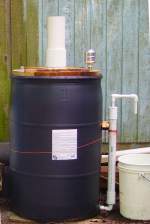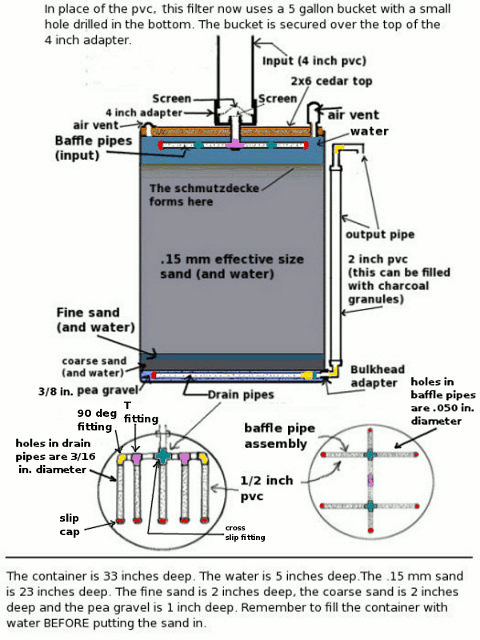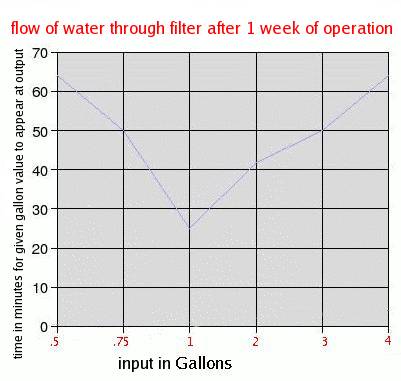|
||||||||||||||||||||||||||||||||||||||||||||||||||||||||||||||||||||||||||||||||||||||||||||||||||||||||||||||||||||||||||||||||||||||||||||
|
|
Specific details

 These filters work, and they work quite well. The idea is not new, but the idea of intermittant use is. The idea is to give the filter a constant supply of oxygen so the biological process that takes place in the top layer of the sand can continue. This is done by maintaining 3 to 5 cm of water above the surface of the sand. I recommend 3 cm (a little over 1 inch - 2.54 cm = 1 inch), the more oxygen the filter has the better it will work. Maintenance: Periodically slow sand filters or biosand filters must be cleaned because as the biofilm matures material accumulates on top of the sand inside the filter causing the flow rate to decrease. The top layer of sand must be carefully cleaned by first plugging the output spout (to prevent the excess biofilm and silt from traveling down into the filter bed) and gently agitating the water and the top surface of the sand. The excess build-up of silt and biofilm in the top 2 to 5 centimeters of sand are broken loose and the excess "silt-like material" and biofilm allowed to drain off while fresh water is added through the baffle until the "drained off" water is running clear. The extent to which the top layer of sand is disturbed will determine the length of time the filter must run to build up the biolayer so it effectively filters the water. I suggest if you are not sure about the effectiveness of your cleaning process, and have no way to test the water, have 2 systems running started about 3 weeks apart. That way each system can be cleaned alternately allowing a continuous supply of water to be available. With a basic understanding of the operation of these water filters (read the info found by clicking on the links below), the cleaning process can be accomplished by just about anyone. Be careful, however because the thicker the biofilm layer the better the filtration. It is a matter of maintaining a balance between flow rate and water purity. To be safe, allow 3 weeks of running time after cleaning before consuming the water. NOTE: DO NOT "BACKWASH" A SLOW SAND FILTER, OR A BIOSAND FILTER. DOING SO WILL DISTURB THE SAND LAYER FORMATIONS IN THE FILTER, AND DESTROY ITS EFFECTIVENESS. Backwashing is used on rapid sand filters. Rapid sand filters are used in large municipal water supply treatment facilities. If your filter is to be outside or where the temperature may get below 0 degrees centigrade (32 degrees F). DO NOT GLUE THE PVC PIPE UNLESS THERE IS A WAY FOR THE WATER TO EXPAND WHEN IT FREEZES. If you do glue the pipe and the water cannot expand as it turns to ice, you will be sorry. If the pipe is not glued, or if there is room for the water to expand the freezing water will just loosen or disconnect the pipe or extend past the opening - you may loose some water but you can put the thing back together easily. If the pipes are glued and there is no room for expansion, they will crack and you may not even know it, but you will have to replace them. This just happened to me - I did not glue them - and just finished putting it back together. 2008/01/20. Be careful, however, because if the pipes leak below the water level and the top of the sand is exposed to air, the filter's biofilm will die and foul the entire filter. This is a huge problem - all the sand may have to be removed and sterilized or water must be allowed to run through the filter for quite some time at a rapid rate to remove unwanted odors. Then the filter must be run for at least another 3 weeks and the water tested again before it can be used. Just make sure the filter has a way to keep the surface of the sand covered by water and a way to maintain access to oxygen because the filter's biofilm must be able to "breathe" - its functionality depends on aerobic organisms that get their oxygen from water. There must be a baffle where the water is added or the biological layer will not form correctly because it will be disturbed every time water is added. Use coarse sand for the bottom layer and fine sand for the top 20 or 30 centimeters. Check the sand before you put it in the device to be sure it is clean, and be sure the device is where you want it and that the weight will be supported. As the filter is assembled, washed sand must be used or the water running through the filter will take quite some time to clear up. To clean the sand use a screen covered with a cloth. Put the sand in the cloth and run water over it until the water draining off of it is clear. For an intermittant filter you will want about 1 inch of water over the top of the sand, much more and there will not be enought oxygen to keep the biological layer alive. Allow at least 2 weeks before using the water. I would recommend 3 weeks and having it tested first. If the sand used is not thoroughly washed the water will not come out clear for some time depending on how much silt is still left in the sand. The filter should be at least 3 feet deep, and have drain system at the bottom similar in construction to the baffle only with larger holes drilled in the pvc pipes, some pea gravel to cover the collection system and then coarse sand over that. To keep 1 inch of water over the sand top bring the output pipe up to 1 inch above the top of the sand. The layer of biological material and activity is in the top layer of sand and to a lesser extent the coarse layer of sand and is where pathogens are metabolized. It helps to use a charcoal (carbon) filter on the output to help remove color. Make sure the carbon is approved for potable water. Water must be run through the filter continuously for 2-3 weeks. At a minimim maintain 3/4 inch water level above the sand by setting the ouput pipe at the corresponding length.Important: When constructing the filter, at the time the sand is put in, be absolutely sure no air pockets form or the filter will foul itself within several days and the water will not be safe and will likely have a very bad odor. This is because the organisms that grow in the aqueous solution must have water and oxygen continuously or they will die and decompose destroying the filter's operation. Fill the container with water first then add the sand and watch for bubbles to stop - this indicates the sand is saturated with water. Size of sand: The size of the sand is critical.Graded sand is the best choice. The product description will say something like "4010" followed by "10 percent retained on 40 mesh or coarser" and may include a statement about the effective size for filtering like ".15 mm ES" (Effective Size). The sand used in the most recent version of the filter described on this website is .15 mm ES graded white silica sand. The most recent version of this filter (2007-11-01) has had water tested "pre filter" and "post filter" and is fully functional. The "uc" (Uniformity Coefficient) of the sand used should be less than 2 with an effective size of .15mm to .35mm . What about "silica sand"? Silica is a very common component of most sand on the earth. In fact it is so common that the EPA doesn't have any specifications on how much should or should not be in water. The problem with silica is that it is harmful to breathe the dust from it - very harmful - but it is also harmful to breathe water - probably more harmful. Graded silica sand can be purchased in small amounts and is probably the best way to assure proper operation of the filter. When silica sand is wet there is not enough dust to be harmful. When in water in small amounts, silica is not harmful enough to be of concern; in fact silica sand is used to filter water in many water treatment plants all over the country. If you use "silica" sand, don't breath the dust and wash it before you use it. What about sand in general - what kind of sand should be used? Sand is quite abundant on the earth, unfortunatly so is pollution that can find its way into sand. Also naturally occuring substances such as arsenic, mercury, lead and asbestos are sometimes found in sand. WARNING: Know exactly where the sand you use comes from and what is in it before you ever drink any water that has passed through it in your filter. There are two standards that suppliers/manufactures can choose to use, (National Sanitation Foundation)NSF 061 and/or (American Water Works Association) AWWA B100-01. I would highly recommend buying your sand from a manufacturer that adheres strictly to these standards, or use a high quality ten stage carbon filter on any water from your filter you intend to consume (this would not be a bad idea no matter what kind of sand you use). The following website has listings of NSF certified sand suppliers and processing facilities: http://www.nsf.org/Certified/Common/Company.asp?Standard=061 Two of the companies listed at this nsf.org site have supplied the sand used in the filters described in the study described on this website They are: MANUFACTURERS MINERAL COMPANY in Washington state and Cemex in Californa. They are wholesale. You will need to find a hardware store, or building supplier near you to order products from them. Pipes used The piping is all pvc pipe designed for use in drinking water systems. With the exception of the large connector sleeve on the 4 inch pvc, most of the fittings can be purchased for under 1.00 dollar each. The coarse sand and the fine sand are 30.00 dollars per cubic yard, the top layer of extra fine sand is 10.00 dollars for a 100 lb bag. The barrel holds .2 cubic yards which is less than 1.00 for the coarse sand and the fine sand used in the first 6 inches of sand. Four bags of the extra fine sand was used - that's 40.00 dollars for the sand. The cedar 2X6's were 50.00 and from those, 5 barrel tops were made - 10.00 dollars for the top. All the pvc couplings and pipe used cost 18.00 dollars. The screens and washers cost 6.00 dollars. The screens used in the input filter are stainless steel. The fancy vent on top was 7.00 dollars. The gravel used in the bottom cost under 1.00 dollar. The water, from rain is free. The total cost so far is 81.00 dollars. In this filter, water collected from the roof of a rural building is being used. The water is run through the filter on an intermittant basis, not a continuous flow as in a large slow sand filter. Enough water must be added to keep the biofilm alive by supplying oxygen dissolved in the water. In testing this filter, water has been added daily: once in the morning and once in the evening in volumes of at least 4 litres about (5 quarts) at a time. Coarse, fine and graded sand are used as the filter media. The pea gravel keeps the sand from interfering with the functioning of the water collection pipes. Since some the sand used in the first version of this filter was not "graded" sand, a random sample was taken from each supply of sand. After measuring, with a micrometer, each individual particle size discernable within reading distance (14 inches) each of these samples were examined and found to have 2 size groups of particles, large and small. The coarse sand having 40% large particles and the fine sand having 10% large particles. The small particles (not discernable from a reading distance as individual) in each sample were measured with a micrometer in 30 each random events giving a statisticly accurate indication of the average and median sizes of the finer portions of sand in each sample. Random samples of the totally dry, coarse and fine and extra fine sand used in the filter, were placed in separate identical 1 gallon containers respectively; and water was added to each container in carefully measured amounts of 1 ounce each until the water appeared on the surface of the sand in each container. This way it was determined that the fine sand holds 49 percent water and the extra fine sand holds 50 percent water by volume when saturated; and the coarse sand holds 37.5 percent water by volume when saturated.  Size of the Sand used: The graded sand used was 4010 (10 percent retained on 40 mesh or coarser) and .15 mm effective size industrial quartz. On the ungraded sand, measurments were taken (in inches) with a micrometer and 30 random samples of the fine portions of both sand types were taken and the measurments recorded.
The 55 gallon barrel used in this filter is filled such that there is room for approximately 21 gallons of water saturating the sand including the water that must be on the surface. Twenty gallons of water are in the saturated sand. This means it takes 5 hours for a complete change of water in the system if 4 gallons are added regularly over a 5 hour period. The flow action of the filter is close to linear above 1 gallon of water added at a time until the water stops running out. Below that level it takes much longer for the water in the filter to be completely replaced. Adding 3/4 of a gallon at a time is the safest way to operate the filter, and still get a fairly acceptable flow rate. 2008-01-20: The filter has been operating for 4 months and the maximum flow rate is 12 litres (3.17 gallons) per hour. The water added has been a combination of continuously recirculated filtered water at a rate of 10 litres per hour combined with the addition of 10 litres of unfiltered water added every 24 hours. The average temperature has been 40 degrees F. A test will be done subsequently and the results posted as time and finance permits.  Rainwater volume calculation formula: Back to introduction (Square footage of roof) X (Inches of rainfall) X (.62414) = volume in gallons This formula is derived based on: 1 cu. ft. = 7.481 gallons 1 cu. ft. = 1728 cu. in. Keep in mind that the area of your roof is not necessarily the same as the area figured from linear measurements around the outside of your house. Most roofs have eaves and slope. Also the type of roof, and the use of a "first flush diverter" will disgard some of the water (a diverter may disgard as much as 10 percent per rain event - this discarded water can be used for irrigation of decorative landscaping and tasks that do not involve direct or indirect consumption - for example; if you water your lawn with this water and then use the clippings in a compost pile you are still concentrating the poison) NO MATTER WHAT KIND OF ROOF SURFACE YOU HAVE,DO NOT USE RAINWATER COLLECTED DIRECTLY FROM A ROOF FOR WATERING A VEGETABLE GARDEN. WITHOUT A DIVERTER THE WATER WILL CONTAIN CONCENTRATED POISONS THAT MAY BIOACCUMULATE IN PLANTS.THIS WILL VARY WITH TIME BETWEEN RAIN EVENTS AND HOW FAR YOUR ROOF IS FROM SOURCES OF AIR POLLUTION. For a roof with a 4/12 pitch with 2 foot eaves add 25 percent to the "linear measurement area result". This chart may help: pitch: square foot increase: 1/12 ------- 20 percent 2/12 ------- 21 percent 3/12 ------- 23.5 percent 4/12 ------- 25 percent 6/12 ------- 34 percent 7/12 ------- 39 percent 8/12 ------- 44 percent An 1800 square foot roof will collect approximately 2000 gallons of water from 2 inches of rain. The nature of the surface of the roof (smooth or rough), combined with the frequency of rainfall periods will determine exactly how much water can be collected. The use of a "first flush diverter" is manditory if the water is to be used for anything other than irrigation of landscaping vegetation.The diversion process will subtract at least 10 gallons per 100 square feet of roof area at the beginning of each rain event. If you live in an area that gets 12 inches of rain a year that would be: close to 12,000 gallons of water - not a lot but certainly helpfull and free, after the filter and storage are paid for. Some areas get over 35 inches of rain a year.
|
|
|
|||||||||||||||||||||||||||||||||||||||||||||||||||||||||||||||||||||||||||||||||||||||||||||||||||||||||||||||||||||||||||||||||||||||||
 This work is licensed under a Creative Commons Attribution-ShareAlike 2.5 License. terms of use |
||||||||||||||||||||||||||||||||||||||||||||||||||||||||||||||||||||||||||||||||||||||||||||||||||||||||||||||||||||||||||||||||||||||||||||
